STATIC ELECTRICITY
By the end of the topic, the student should be able to;
- Explain the concept of static electricity
- Explain the origin of charges
- Identify the two types of charges
- State the fundamental law of static electricity
- Charge bodies using different methods
- Describe the structure of gold leaf electroscope
- Determine the sign of charges
- Identify the steps of charging and is charging a gold leaf electroscope
- The student should be able to:
- Distinguish between a conductor and an insulator
- Explain the concept of capacitance
- Explain the mode of action of a capacitor
- Describe the construction of air filled capacitor
- Determine equivalence capacitance of a combustion of capacitor
- Explain the phenomenon of lightning conductor
- Describe the structure and mode of action of lightning conductor
- Construct a simple lightning conductor
KEY TERMS AND CONCEPTS.
Static electricity- the study of gain of electric charge from an object fro, its charge at rest.
Charge- particles carrying electric current
First law of electrostatic- states that like charges repel while unlike charges attract.
Charging- the process whereby materials loose or gain electrons.
Friction method of charging- two objects are rubbed against each other to charge a neutral one.
Earthing- flow of electrons to the ground
Gold leaf electroscope- an instrument used used for detecting electric charges.
Conductor- a solid object that conducts electricity
Insulator- a material that does not allow electric current to pass through.
Capacitor- device used to store electric charge
Farad- this is the S.I unit of capacitance
Capacitance- ability to store electric charge by a body
Potential difference- this is work done that is needed to move a charged particle from one point to another.
Lightning- giant electric spark that arises due to discharge of atmospheric electricity.
Radar-zigzag path in which few electrons move across passing wind towards positive charge.
Thunderstorm- this is audible sound called thunder produced by air around a radar.
Introduction.
Static electricity is the study of when an object gain electron from its charge at rest. Static electricity also called stationary electricity.
Charge
Charge is the particles carry either positive particle or negative particle
Origin of Charges
When body rubbed cause the atoms to loose or gain electron which are revolve around atomic structure result causing the body to become charged. Due to that reason it tends to cause;
(a) Plastic materials are rubbed on a cloth/hair attract dust and small pieces of paper
(b) Particles of wheat are attracted to amber.
(c) The moving parts of machinery, car tyres, and vehicle bodies they attract light particles
(d) Ebonite rubbed with fur/cloth attract dust and small pieces of paper
(e) Glass rubbed with silk attract dust and small pieces of paper
(f) polythene rubbed with fur/cloth attract dust and small pieces of paper
(g) polystyrene rubbed with fur/cloth attract dust and small pieces of paper
(h) Perspex rubbed with woolen cloth attract dust and small pieces of paper
(i) cellulose rubbed with woolen cloth attract dust and small pieces of paper
(j) some clothes cling to the body
(k) comb rubbed with sleeve attract piece of paper
(I) crackling noise while remove nylon cloth
Types of Electric Charges
There are two types of charge include
Positive charge (+)
Negative charge (-)
Positive charge
Positive charge is a charge acquire when an object loose electron from its atomic structure.
Negative charge
Electrons are revolve around the nuclear
Electrons are moved from one atom to another
Protons never move from one to another atom
Charge acquired after rubbed
| Materials | Rubbed with | Charge acquired |
| Ebonite | Fur/cloth | Negative |
| Glass | Silk | Positive |
| Polythene | Cloth/fur | Negative |
| Polystyrene | Cloth/fur | Negative |
| Perspex | Woolen cloth | Positive |
| cellulose | Woolen cloth | Positive |
Fundamental law of electrostatics
The fundamental law of electrostatics which states that
"Like charges repel, unlike charges attract each other"
Also is called fundamental law of static charges or first law of electrostatics
Charging
Charging is the process whereby material loose or gain electrons
Methods of Charging
There are three methods as
Rubbing or friction method
Conduction or contact method
induction method
Friction Method
When you rub two objects the one which his outer most shell weak bound will lose and the one have sparsely electron gain the electron. Due to that electrons shift from one object to another and tend to gin one to become negative charged and lose one become positive charged.
Contact Method
When charge and uncharged body contact the charge always move from![]() charge repel and unlike charge attract. Consider the two charge body (y) and uncharged body (x)
charge repel and unlike charge attract. Consider the two charge body (y) and uncharged body (x)
Touch y to allow movement of electrons to ground. The movement/flow of electrons to ground is called Earthing
Since like charge repel each other positive charge will shift/migrate from y to x
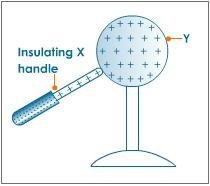
Electrophorus
An electrophorus consists of a metal disc made of brass fitted with an insulating handle (usually an ebonite rod) resting on polythene base. It can produce numerous positive charges from a single negative charge.
Now uncharged (x) became positive charged
Induction Method
When two body charge and uncharged body keep near, charged body causes the other body to gain opposite charges to the one of the charging body. Consider the two charge body (x) and uncharged body (y)
Charging an Electrophorus
Electrophorus is charged by induction. The polythene is given a negative charge by rubbing it with fur causing positive charge to be induced on the upper part of the brass plate, and a negative charge on the lower part of the brass plate will leave the polythene plate charged negatively. The electrophorus is left with an excess positive charge
Diagram:
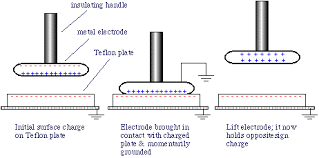
Since like charge repel, unlike attract each other negative charge will pull positive and push negative charge
Gold Leaf Electroscope
Gold leaf electroscope is an instrument for detecting/identify the presence of an electrical charge on an object. The gold leaf electroscope consists of gold leaf and a brass rod of metal held by insulating materials.
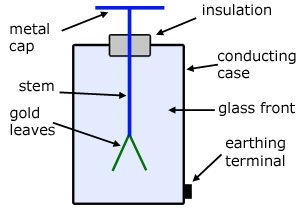
The brass cap, brass rod and the gold leaf form the conducting part of the electroscope.
Charging an Electroscope
It charged by contact and Induction
Charging By Contact
When charge and uncharged body contact the charge always move from charged body to another because like charge repel and unlike charge attract. Therefore the charged one when brought to contact with metal cap result to charge metal cap and became charged.
Charging By Induction
A negatively charged rod is brought near the brass cap of the gold leaf electroscope. Induced charges are formed with brass rod acting as conductor.
Test for the sign of charge on a body
i. It used to test whether charge is positive or negative. In order to identify the charge of a body we should use a charged electroscope. Let us say the electroscope is negatively charged.
Now bring the unknown charged body X near the cap of the electroscope.
- If the leaves diverge more the charge in X must be negative. Suppose that the leaves close a little when X is brought near C, then X may have a positive charge or it may not have any charge.
- In order to confirm the positive charge you must bring the rod X near the cap of a positively charged electroscope.
If the leaves diverge more, then X has positive charge and vice versa.
Uses of Gold Leaf Electroscope
A gold leaf electroscope has a number of functions the follows are some of them
Test for the sign of charge on a body
Identify the insulating properties of material
Detect the presence of charge on a body
Nb:
i The leave diverge/increase due to high concentration of charge
ii The leave converge/decrease due to low concentration of charge
Table of summary of charges and their effect
| Charge on electroscope | Charge brought near cap | Effect on leaf divergence Increase |
| + | + | |
| - | + | Increase |
| + | - | Decrease |
| - | + | Decrease |
| + or - | Uncharged | Decrease |
Identify the insulating properties of material
An electroscope that is positively charged can used to test for the insulating properties of material
If the material that as placed near the cap of an electroscope is a conductor, then the metal leaf will converge and a divergence will show that the material is an insulator.
Detect the presence of charge on a body.
To detect a charge on a rod A or B bring the rod near to the metallic disc or cap of the electroscope. In either case the leaf diverges as shown in the diagram.
Conductor
Conductor is substance which allow electricity to flow through it.
Examples of conductors are metals like iron, copper etc
In conductors electrons are free to move which are conduct charge from one to another.
Insulator
Insulator is a material that does not allow electricity to flow through them. Examples of insulators are plastic, wood, rubber, mica, ebonite and glass. In insulators there are no free electrons for conduction.
Insulators and conductors are sometimes applied together in electric power usage.
Capacitors
Capacitor is device used to store electric charges.
Nb:
The ability to store electric charges is known as capacitance.
SI unit of Capacitance is Farad
Capacitor are found in all electronic circuits, e.g. in radios, television, alarm systems,.
The potential difference (Voltage produced by cell/battery), V across the two capacitor plates of the capacitor is directly proportional to the charge, Q accumulating on its plates
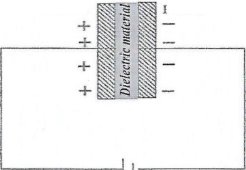
V α Q
Remove proportional sign
Q = kV
Where k is proportional constant called capacitance, C
then Q = CV
Charging a Capacitor
A capacitor consists of two metal plates (say plate A and plate B) arranged in parallel with a dielectric material between them.
The two plates accumulate charges when a potential difference is applied across them.
Potential difference is the work done needed to move a charged particle from a point to point.
Its SI unity is voltage, V. Also called potential
Discharging a Capacitor
- When the two plates of a capacitor are joined, the electrons from the negatively charged plate will flow around the circuit and neutralize the positive charges on the positively charged plate.
- This movement of electrons will cause a current to flow for a short time and if you are using a wire to connect the two plates you can draw a spark. When the current stop flowing, the capacitor is said to be discharged
Types of Capacitors
There are different types of capacitors depending on the dielectric material used and the application.
Paper/plastic filled capacitor
Oil filled capacitor
Electrolytic capacitor
Mica capacitor
Variable/ air filled capacitor
Paper Capacitor
It this paper/plastic/polyester material is used as dielectric material. It has metal foil strip as their conductor.
Oil Capacitor
It this oil material is used as dielectric material.
Electrolytic Capacitor
Its contain paper material soaked in a chemical as conduct and a thin aluminium oxide is formed on the positive plane. The thinner the layer higher the capacitance
Mica Capacitor
In mica a sheets of metal foil are separated by strips of mica. Mica is preferred because it is a natural mineral and splits easily into thin sheets
Variable Capacitor
Conduct are semicircular plates are separated by air ad dielectric material. One set of plate is fixed and other is rotate by means of the knobs. The rotation changes the area of the plate
Arrangement of Capacitors
Capacitors can be arranged in series or in parallel to get the desired effect:
Arrangement of capacitors in series
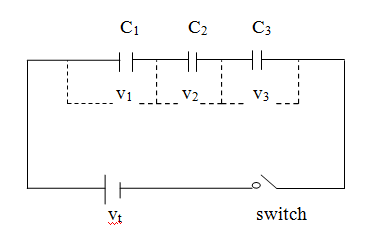
From the diagram above
Vt = VI +V2
But: Q = CV - make v subject
V= C/Q
Therefore:
Vt = Qt/Ct
V1 = Q1/C1
V2 = Q2/C2
But: charge store is equal but each of capacitor
Qt= Qt =Q2= Q
Modify:
Vt = Q/Ct
V1 = Q/Ct
V2 = Q/C2
Where:
First capacitance = CI
Second capacitance = 02 Effective capacitance = Ct Charge from capacitance, C1 = Qi Charge from capacitance, 02 = Q2
Total capacitance, Ct = Qt Voltage across capacitance, CI =
Voltage across capacitance, C2 = V2 Total voltage across capacitance, Ct = Vt
From: Vt = vi + v2- Substitute each
Q/Ct = Q/Ct + Q/C2
Q/Ct = Q (1 /C + 1 /C2) - divide by Q both sides
1 /Ct = 1 /CI + 1/C2
Therefore for capacitor in series their total capacitance is obtained by formula;
1/Ct = 1/C1 + 1/C2
Capacitors in Parallel
From the diagram above
Qt=Q11-Q2
But: Q = CV
Therefore: Qt = CtVt Qi = C1V1 Q2 = C2V2
But: voltage across each capacitor is
equal
Modify:
Qt = CtV Qi = CIV Q2 = C2V
From: Qt= Q1 + Q 2- Substitute each CtV = Q(C1 V + C2V)
CtV = V(Ci + C2) - divide by V both sides Ct = CI + C2
Therefore for capacitor in series their total capacitance is obtained by formula;
Ct = Ci + C2
Example,
Two capacitors of 20 µF and 25 µF are connected in (i) series, and (ii) parallel. What is the effective capacitance for (i) and (ii)?
Data given
First capacitance, CI = 20 µF
Second capacitance, C2 = 25 µF
Effective capacitance, Ct= ?
Solution
(i) Series
From: 1/Ct = 1/Ci + 1/C2
1 /Ct = 1/20 + 1/25
1/Ct = (5 + 4)/100
1/Ct = 9/100
Ct/1 = 100/9
Ct =11.11 µF
(ii) Parallel
From: Ct = CI + C2 Ct = 20 + 25
Ct= 45 µF
Example,
Determine the effective capacitance obtained when two capacitors each of 10 µF are connected first in parallel and then in series.
Data given
First capacitance, C1 = 10 µF
Second capacitance, 02 = 10 µF
Effective capacitance, Ct = ?
Solution
(i) Series
From: 1 /Ct = 1/Ci + 1/C2
1/Ct= 1/10+ 1/10
1/Ct = (1 + 1)/10
1/Ct = 2/10 Cill = 10/2 Ct = 51.1
(ii) Parallel
From: Ct = CI + C2 Ct = 10 + 10
Ct = 20 µF
Example,
It is required to obtain effective capacitance of 3 uF, there are two capacitors; the first is 12 µF, what will be the value of the other capacitor. State the way it will be connected to the first.
Data given
First capacitance, CI = 20 uF
Second capacitance, C2 = ?
Effective capacitance, Ct. 2 uF
Solution
(i) Series
From: 1/Ct = 1/Ci + 1/C2
1/3 = 1/12 + 1/C2
1/C2= 1/3 - 1/12
1/C2= (4 - 1)/12
1/C2= 3/12
1/C2= 3/12
C2/1 = 12/3 = 4
Ct = 4 uF
It will be connected in series to the first one and its value will be 4 uF
Factor Affecting Capacitance .
Capacitance of a parallel plate capacitor is affected by three factors, namely
- The area of plates
- The dielectric material
- The distance between plates
Area of Plates
An increase in the area of the plate causes a decrease in potential difference between the plates, hence an increase in capacitance.
Cα 1/V
Dielectric Material
Dielectric material will cause the capacitance to increase or decrease depending on the material. Example, capacitance increases if we use dielectric material such as glass or book or polythene between the plates rather than air.
Distance between Plates
A decrease in the distance between plates causes a decrease in potential difference between the plates, hence an increase in capacitance.
C α1 /d
Charge Distribution
Scientists and engineers have developed several experiments to prove the distribution of charge as;
- Hollow object only have charge on their outer surface
- Charge is normally concentrated on the sharp points of conductor

(i)
Lightning
Lightning is a giant electric spark that arises due to discharge of atmospheric electricity
Or
Lighting is sparking on a very large scale
How Lightning Happens
Occurs when water molecules (clouds) in the sky rubbed each other resulting the lower portion of clouds become negatively, the upper portion of clouds become positively while ground become positively after induced by lower portion.
Diagram
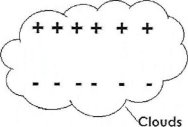
Land
![]() +++++++++++++
+++++++++++++
When wind passes across clouds, a few electrons move across the air toward positive clouds but in zigzag path called Radar
Thunderstorm
Air around the radar undergoes rapid expansion and contraction due to overheating causing high speed of air molecules. This produces an audible sound called thunder
Lightning Conductor
Lightning conductor is a long pointed conductor at the top reaching high above the highest point of a building connected to earth by a thick cable to earth rod
Or
Lightning conductor is a metal rod with tip has sharp spikes attached to a build and connected to a thick copper strip that leads into the ground
Lightning conductor
A
I
Function of Lightning Conductor
To protect buildings from being struck by a lightning
Mode of Action
With a thunder cloud forming or passing close to the house as depicted, the sharp point of the lightning conductor becomes inductively charged opposite to the thunder cloud. The resulting high electric field ionizes the air in the vicinity such that the charged air molecules move upwards earth rod to the ground. This action discharges the thunder cloud, thereby preventing a lightning flash occurrence.
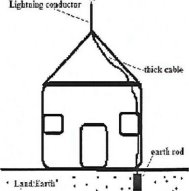
TOPIC SUMMARY.
Static electricity is the study of electric charges
Charge- are particles which has a negative or positive charge
There are two types of charges, positive and negative charge
The fundamental law of electrostatic states that like charges repel while unlike charges attract.
There are three methods of charging a body, by contact, by induction or by friction.
A gold leaf electroscope- is an instrument used to detect presence or identify the type of charge.
An electroscope can be used to charge a body, identify the type of charge, identify the insulating property, and detect the presence of charge.
Conductor is a solid substance that allows charges to pass through it.
Insulators- materials that does not allow electricity to flow through them
A device that is used to store charge is called a capacitor
The main types of capacitors are paper filled capacitor, oil filled capacitor, electrolytic capacitor, mica capacitor, and variable air filled capacitor
Capacitors can be arranged in series or in parallel
Capacitor is affected by area of plates, dielectric material and distance between plates.
www.learninghubtz.co.tz
TOPICAL QUESTIONS: FORM TWO.
STATIC ELECTRICITY
SECTION A:
MULTIPLE CHOICE QUESTIONS.
1. For each of the following items, choose the correct answer from among the given alternatives and write its letter in the box provided.
(i) The study of charge at rest is known as:-
- Current electricity
- Electronics
- Electrostatics
(ii) The following are types of charges:
- Positive charge and negative charge
- Positive charge and neutral charge
- Negative charge and electrons.
(iii) Charges acquired by glass when rubbed with silk.
- Negative
- Positive
- No charge acquired.
(iv) The process whereby material loose or gain electrons is known as:-
- Charging
- Magnetization
- Earthing.
(v) The following are methods of charging.
- Friction, conduction and reduction
- Conduction, friction and convection
- Induction, conduction and Friction.
(vi) The device which produces numerous positive charges from a single negative charge is called?
- Gold leaf electroscope
- Electrophorus
- Earth wave
(vii) The device which used to store electric charge is called?
- Conductor.
- Gold leaf electroscope
- Capacitor.
(viii) Capacitance is?
- Ability of the capacitor to resist the flow of electric current.
- Ability of the resistor to store electric.
- Ability of the capacitor to store electric charge.
(ix) A giant electric spark that arises due to discharge of atmospheric electricity is known as.
- Thunderstorm
- Lightining
- Electric shock.
(x) The effective capacitance of three capacitors in series is given by:
- C1 + C2 + C3
2. Match the phase in List A with responses in List B by writing the letter of the correct response in List B.
| LIST A | LIST B |
| (i) Positive charge (ii) Cellulose (iii) Induction method (iv) Gold leaf electroscope (v) Factors affecting capacitance (vi) Lightning conductor.
|
|
3. (a) Define the following terms:
(ii) Static electricity
(iii) Charging
(b) Mention types of electric charges.
4. (a) State the fundamental low of electrostatics.
(b) List three methods of charging.
5. (a) What is electrophorus?
(b) With the aid of diagram explain briefly how electrophorus is charged.
6. (a) What is Gold leaf electroscope?
(b) Draw a well labeled diagram of Gold leaf electroscope.
7. (a) List three uses of Gold leaf electroscope.
(b) Fill the table below.
| Charge on electroscope | Charge brought near cap | Effect on leaf divergence |
| + | + |
|
| - |
| Decrease |
| + | - |
|
|
| - | Increase |
8.(a) (i) Insulator is a material…………………………………
(ii) Conductor is a material……………………………….
(b) (i) What is capacitor?
(ii) What is capacitance? State its SI unit.
9. (a) With the aid of circuit diagram explain briefly the following processes.
(i) Charging capacitor
(ii) Discharging capacitor.
(b) Two capacitors of 20MF and 25MF are connected in
(i) In series
(ii) In parallel.
What is the effective capacitance for (i) and (ii)?
10. (a) Write down the expression for potential difference across the capacitor with capacitance C and charge stored in it be Q.
(b) Given that the potential difference across capacity of capacitance C = 20MF is 2V. Calculate the charge stored in the capacitor.
11. (a) Draw electric fields for the following static charges showing neutral (N) points.


![]()
![]() (i)
(i)
(ii)
(b) In each the circuit below, find effective capacitance and the total stores in each circuit.


![]()
![]()
12. (a) List factors affecting capacitance of a parallel plate capacitor.
(b) Explain briefly how each factor in 12 (a) above affect the capacitance of parallel plate capacitor.
13. (a) Define the following terms:
(i) Lightning
(ii) Thunderstorm
(iii) Lightning conductor.
(b) Explain briefly how lighting happens.
14. Complete the distribution of charge in each of the following diagram.
![]()
![]()
![]()
![]() (a) (b)
(a) (b)
Hub App
 For Call,Sms&WhatsApp: 255769929722 / 255754805256
For Call,Sms&WhatsApp: 255769929722 / 255754805256
 For Call,Sms&WhatsApp: 255769929722 / 255754805256
For Call,Sms&WhatsApp: 255769929722 / 255754805256
WHATSAPP US NOW FOR ANY QUERY
App Ya Learning Hub Tanzania








